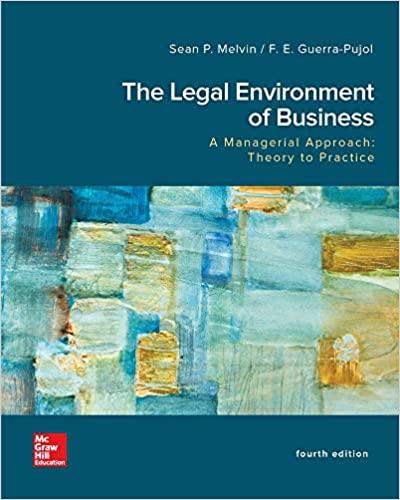Question
Transtar Airlines had an eight-year-old jumbo jet called the Triton made by Laugheed-Doughless. The Triton was an aviation marvel and it transported 300 passengers per
Transtar Airlines had an eight-year-old jumbo jet called the Triton made by Laugheed-Doughless. The "Triton" was an aviation marvel and it transported 300 passengers per flight. It had three engines. On the Friday evening before the July 4 holiday, the plane carrying 289 passengers was cleared to fly from Detroit to Seattle as flight #123. Air Traffic Control (ATC) cleared Transtar Flight #123 to taxi from the gate to the runway 27R. The winds were blowing out of the east from 090 at 30 knots. So, ATC cleared Transtar #123 to take off with a tailwind notwithstanding the aviation practice of taking of with a headwind. ATC did this because they did not want the airport to deal with phone calls from neighbors who moved in close to the airport recently and did not like the noise of jet traffic.
As Transtar #123 lined up, the first officer applied full throttle, and the aircraft lifted off. As the aircraft lifted off, the right engine broke off without warning, the procedure the flight crew was trained in, was to reduce thrust and increase pitch of the aircraft (pointing upward). The plane climbed to about 150 feet above the ground. However, when the engine broke off, the engine also severed the primary and redundant hydraulic lines on the right wing. Since both hydraulic lines were severed, the aircraft lost hydraulic fluid and because of the loss of hydraulic fluid the leading edge and trailing edge flaps retracted. The right wing lost all lift, and the aircraft went into an incipient spin and the plane went nose first into the ground. All passengers and 12 crewmembers were killed along with 10 people on the ground.
After a thorough investigation, it was found that the maintenance facility at Transtar did not follow the aircraft manufacturer's Laugheed-Doughless procedures for regular maintenance on the right engine. Investigators also determined that because the plane took off with a tail wind, it should have been able to climb to 500 feet with a head wind which may have given the flight crew some more time to troubleshoot. Also, the investigators determined that the training the flight crew received should have received was to apply full thrust and not increase the pitch, but rather keep a steady attitude and apply full thrust.
The relatives of some of the passengers come to you with specific questions. (Answer in full sentences, proper syntax, punctuation and form, and answer each question with the corresponding number).
- In what capacity would the relatives bring a legal action? (2)
- What specific parties would the relatives sue? In other words, who would be named as possible defendants in this case?) (5)
- What causes of action would the relatives attorneys use to sue the potential parties? (5)
- What are the elements of those specific causes of action that you stated in Question #3? (5)
- What defenses could potentially be used by the defendants? (3)
- Who do you think would win and why? Use the "IRAC" method here, answer the question)(IRAC) (25 points)
- What specifically would the plaintiffs be suing for? (2)
- What legal tool would be used to satisfy a judgement or a settlement? (2)
- Can ATC be sued and if so, under what legal theory? (1)
Step by Step Solution
There are 3 Steps involved in it
Step: 1

Get Instant Access to Expert-Tailored Solutions
See step-by-step solutions with expert insights and AI powered tools for academic success
Step: 2

Step: 3

Ace Your Homework with AI
Get the answers you need in no time with our AI-driven, step-by-step assistance
Get Started


